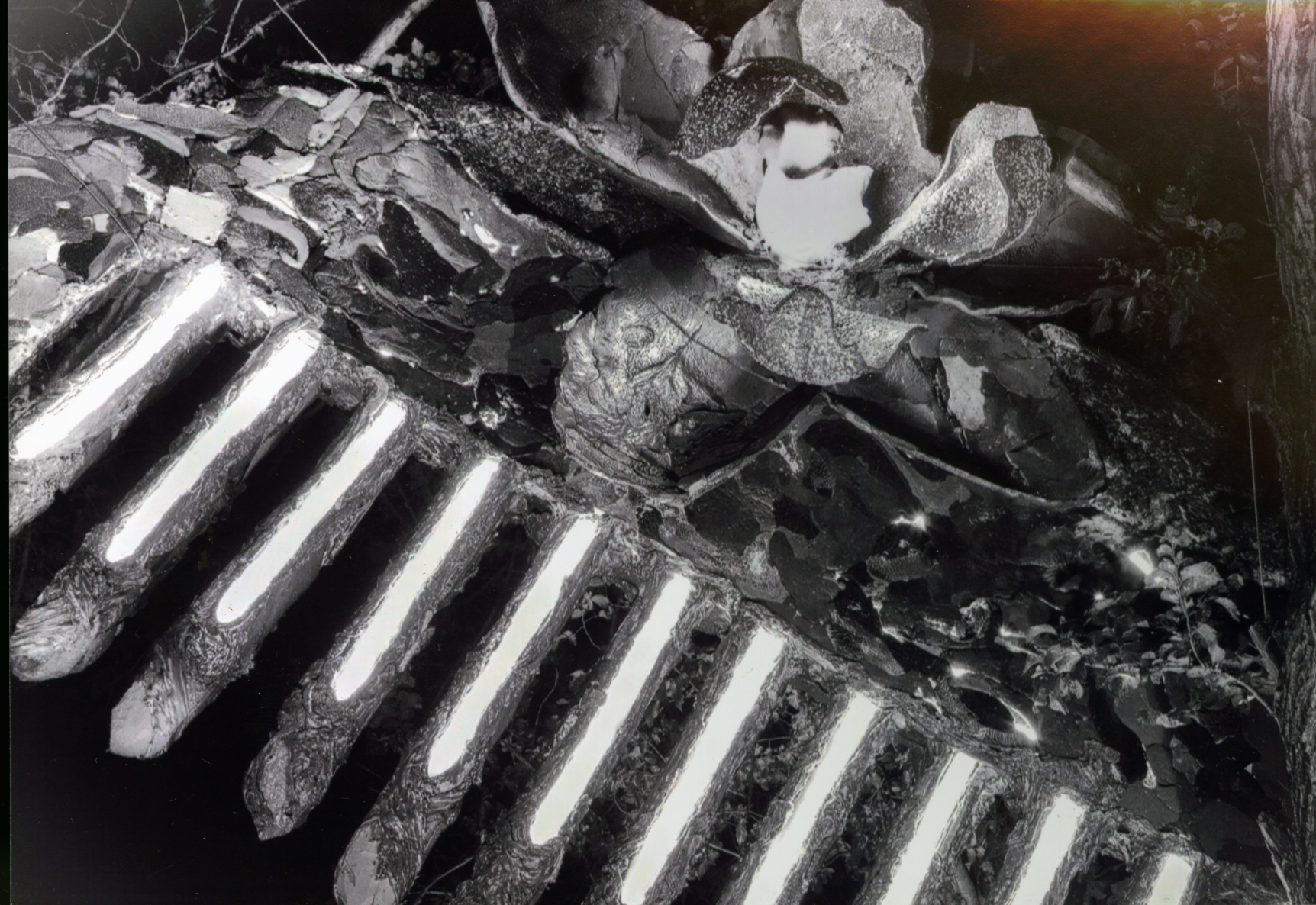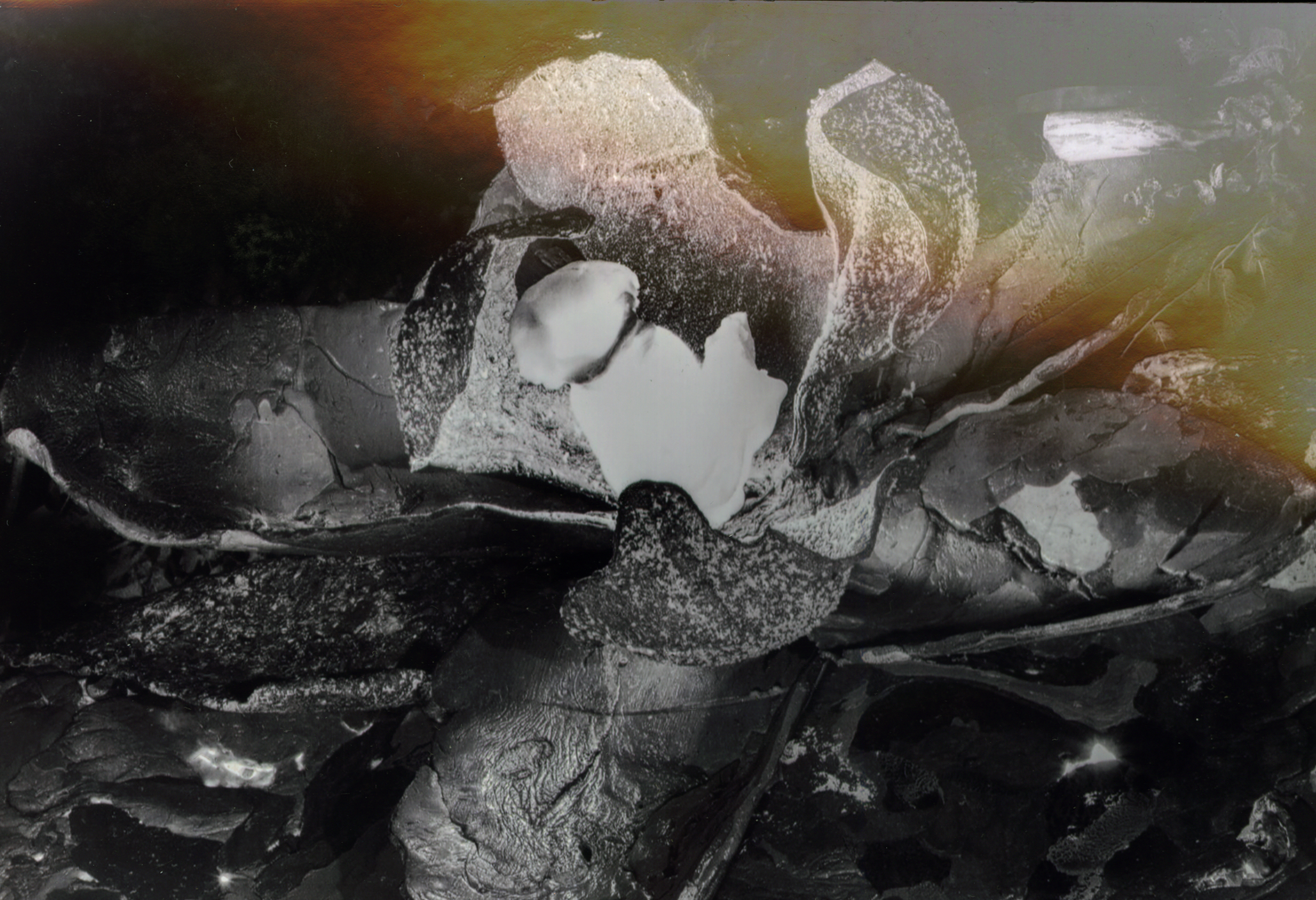Le Peigne
Le Peigne
Written by Wawa Li
Pictures by Jessy Colucci
March 8th 2023
Pictures by Jessy Colucci
March 8th 2023
Last summer, Studio Ascètes, Sarah Tu and I presented The Comb (Le peigne), a sculpture that we created for the 2022 Asian Night Market. At the North gate of Montreal's Chinatown, the large art piece sat in the tree at the center of the event space. This story dissects a comb in parts, explaining the process behind the production. Today, on March 8th 2023, we remember the fights for better work conditions and egalitarian futures that were initiated by women and their supporters. Building upon conversations on sustainability, we use art to tell the humble story behind The Comb: an art piece made for mothers, daughters and women who still go to work despite their periods.
![]()
The Teeth
The Chinese character for "comb" (梳) is composed of the character wood (木) on the left and a visual representation of a comb on the right. A comb is a tool for care; I believe comb’s teeth were thought to be like human fingers.
The sculpture approaches sustainable solutions with acknowledgement, like how my mother used our rice water as a facial cleanser. For my family, everything has potential until the last breath. Objects are also products of labor and human ingenuity. Thus, in this way, part of nature. In my father’s garden, there are seeds potted in reused ramen cups. When the plant is grown, the ramen cup will be torn open to serve as a cover to protect a table from dirty tools.
Up until this day, we found that climate issues are studied and communicated through the sterilized paradigm of scientific evidence. Being thrown at alarming data can make it hard for people to feel concerned or for someone to understand how they can take action and leave their imprint. The way I was taught environmental issues often disconnected human beings from nature. My personal journey into the academic institution helped me realize that my most valuable source of knowledge for building a better society turned out to be the wisdom from my community experience and family education.
It is this understanding that nature and humans are inextricably connected that will move us forward to applicable, sustainable solutions.
When the process of building the sculpture began, conversations on gender roles inevitably came to the forefront as our mother played a central role in our education and transmission of legacy. Our parents, especially immigrant mothers, are silent guides powering through various systems — whether it be the underlying patriarchal system embedded in both Western and Asian societies, or the new system where they grew into. Quietly, mothers are the backbone of so many immigrant families. I cherish an old memory of a night peeking through the door of my mother’s bedroom. She was asleep, lulled by the cassette of a French learning program she was playing on her radio. She was hours away from another day of work at the restaurant and picking us up again from kindergarten. Everything was done willingly, she would like me to say. She never complained and completed the requirements successfully. Today, she would say otherwise but she speaks French fluently. A working-class woman’ resilience is unquestionable.
![]()
The Shaft
Patterns found in nature are easily some of the most agreed upon references for beauty reference across cultures and disciplines. This beauty can be found in the most unpolished raw places and can be recreated through repurposing things that we already possess.
Comb-making is an ancient Chinese craft. It has been said that “the transformation of wood into a comb was a difficult process, comparable to a cocoon revealing a butterfly.”1 The production of combs reflected how ancient civilizations studied the cycles of nature. The methods used in the sculpture aim to pay respect to the process of the traditional craft.

The Teeth
A holistic approach to sustainable development
The Chinese character for "comb" (梳) is composed of the character wood (木) on the left and a visual representation of a comb on the right. A comb is a tool for care; I believe comb’s teeth were thought to be like human fingers.
The sculpture approaches sustainable solutions with acknowledgement, like how my mother used our rice water as a facial cleanser. For my family, everything has potential until the last breath. Objects are also products of labor and human ingenuity. Thus, in this way, part of nature. In my father’s garden, there are seeds potted in reused ramen cups. When the plant is grown, the ramen cup will be torn open to serve as a cover to protect a table from dirty tools.
Up until this day, we found that climate issues are studied and communicated through the sterilized paradigm of scientific evidence. Being thrown at alarming data can make it hard for people to feel concerned or for someone to understand how they can take action and leave their imprint. The way I was taught environmental issues often disconnected human beings from nature. My personal journey into the academic institution helped me realize that my most valuable source of knowledge for building a better society turned out to be the wisdom from my community experience and family education.
It is this understanding that nature and humans are inextricably connected that will move us forward to applicable, sustainable solutions.
When the process of building the sculpture began, conversations on gender roles inevitably came to the forefront as our mother played a central role in our education and transmission of legacy. Our parents, especially immigrant mothers, are silent guides powering through various systems — whether it be the underlying patriarchal system embedded in both Western and Asian societies, or the new system where they grew into. Quietly, mothers are the backbone of so many immigrant families. I cherish an old memory of a night peeking through the door of my mother’s bedroom. She was asleep, lulled by the cassette of a French learning program she was playing on her radio. She was hours away from another day of work at the restaurant and picking us up again from kindergarten. Everything was done willingly, she would like me to say. She never complained and completed the requirements successfully. Today, she would say otherwise but she speaks French fluently. A working-class woman’ resilience is unquestionable.

The Shaft
About material sensitivity
Patterns found in nature are easily some of the most agreed upon references for beauty reference across cultures and disciplines. This beauty can be found in the most unpolished raw places and can be recreated through repurposing things that we already possess.
Comb-making is an ancient Chinese craft. It has been said that “the transformation of wood into a comb was a difficult process, comparable to a cocoon revealing a butterfly.”1 The production of combs reflected how ancient civilizations studied the cycles of nature. The methods used in the sculpture aim to pay respect to the process of the traditional craft.
| Excerpt of ancient wooden comb craftsmanship | Excerpt of plastic comb sculptural craftsmanship |
|---|---|
|
|
Plastic is too often thought to be easily disposed of, difficult to re-use and often thought of as undignified. In the design world of today, these beliefs are often behind clients’ requests for plastic, wood, and other materials to be reshaped into smooth surfaces, camouflaging their organic origin. The craftsmanship of Studio Ascètes challenges us to rethink our relationship with plastics and see beauty in the material that is too often misunderstood. Indeed, we often forget that plastic is made from transformed raw natural materials. I wanted people to see beautiful natural elements by showcasing repurposed plastic in a way that honored the natural origins of this material.
The few that were awake in Chinatown on those warm Monday mornings of June were the birds and the people on our team: Sarah, our friend Dimitri (who is a resident of the neighborhood from time to time), and me. In the sleepy streets of Chinatown, you could find us browsing through recyclable garbage to find the perfect HDPE plastic that would otherwise be picked up by the city. I cherish the memory of our weekly meetings with Khana and Moni, two workers from Chinatown’s iconic dim sum restaurants. They had been au poste for a few hours already, preparing delicious food for customers to binge upon opening morning business hours. They had also stacked all of last week’s plastics for us, tied meticulously with handmade Saran wrap threads. We were as excited about the finds as if they were gold.

The Flower
Re-writing the story
We live in a time when marginalized communities are tired of being carried by history. Nowadays, we choose to write our own stories.
The flower sitting at the top of this comb was left intentionally discreet, although it was an important part of the conceptualization thought process.
The magnolia flower, called “木兰花” Mulan flower, carries a heavy cultural background. It has been interesting to deconstruct Mulan’s tale. Digging further into her story and its variations, Mulan has been used and performed in various mediums, such as film, opera, theater, and poetry. In different Asian war contexts, the story of Mulan served as a vessel for nationalist and political ideologies, encouraging people to enroll when needed through the story. Many refer to Mulan as a figure of obedience, moral love, gender equality, etc. In the study of a childhood hero figure, many hard questions arose. Do we end up celebrating the assumption that for a woman to have value, she must uphold an oppressive structure, rather than to dismantle it? In a reality where women are more often than never de-narrativized from their own stories, who are we listening to?
We all come from different backgrounds and there is room for all of our stories of hardship. If marginalized communities want to carry history rather than being carried by it, they will have to stay united, stay strong, and build upon collective conversations where our implications deserve recognition.


The comb
Tying it all together
As working-class artists who are used to working with what we have, limited resources did not stop us from seizing the opportunity to tell a story about collective effort towards a common goal, knowing that throughout history, the vehicle of arts and culture has been used in revolutionary propaganda to generate transformative ideas.
At the crossroad of sustainability and material sensitivity was formed The Comb. This 300-pound sculpture is made with recycled plastic, partly gathered from the Chinatown neighborhood. In a nature-waste paradox, the sculpture aims for a full-circle approach. It reflects the urban nature it occupies.
One could take the perpetual cycle of day and night for granted as for the production process of objects. However, the recognition of the labor and individuality behind each object makes each one irreplaceable, with infinite potential for rebirth. We need to reassess our relationship with objects. Everything possesses upcycling potential. The comb stands at the end of the cycle of consumption, replacing waste with rebirth.
For the longest time, I forgot that solutions are found within our roots. To disseminate the stories of the workers, we have to engage in discourse outside of the world of academia and into our conversations with seniors and mothers—all of those who still have ties with nature. They possess the knowledge to get through what is ahead. For the longest time, I thought my family was using ramen cups as covers because they thought they didn’t deserve better. I used to be ashamed of these practices, because they reminded me that I was the daughter of humble cooks. I was wrong: they did it conscientiously, regardless of socioeconomic realities. Our seniors understand relationships with nature and long-passed generational knowledge much better than we do. We are just seeds, and we need their water.
end.
ACKNOWLEDGEMENTS
A production of the Partenariat du Quartier des spectacles (PQDS), “Moment du coeur de l’île”. The project was developped on uthe traditional territories of Kanien'kehá:ka, Mohawks’ Tiohtià:ke (Montreal) and the Wendake people’s Kebek (Quebec).
ABOUT THE ARTISTS
Wawa Li : Torn between duty and play, Wawa Li’s artistry is an ongoing healing process. Whether it be through garment, programming, installation or videography, her work uses art as a vehicle to re-narrativize. As the elder daughter and family translator, she is inspired by the delicacy and brutality of womanhood. While feeling fruitless in her tai chi apprenticeship, her work fights towards her ancestors' utopia with what she believes to be human’s best weapon: empathy.
Studio Ascètes : Studio Ascètes is a multidisciplinary space that aim to collaborate in sculptural work with alternative and sustainable technics
Sarah Tu : Trained in architecture and event design, Sarah Tu is a space designer based in Montreal. Her non-purist conceptual approach is based on a holistic perception of what design can be, whether built or not, allowing for a multi-scale and multi-disciplinary creative methodology. By sharing the personal experience of being Asian Canadian and as a project manager, Sarah was able to support Wawa in her artistic approach and the team, in the realization of Le Peigne.
A production of the Partenariat du Quartier des spectacles (PQDS), “Moment du coeur de l’île”. The project was developped on uthe traditional territories of Kanien'kehá:ka, Mohawks’ Tiohtià:ke (Montreal) and the Wendake people’s Kebek (Quebec).
ABOUT THE ARTISTS
Wawa Li : Torn between duty and play, Wawa Li’s artistry is an ongoing healing process. Whether it be through garment, programming, installation or videography, her work uses art as a vehicle to re-narrativize. As the elder daughter and family translator, she is inspired by the delicacy and brutality of womanhood. While feeling fruitless in her tai chi apprenticeship, her work fights towards her ancestors' utopia with what she believes to be human’s best weapon: empathy.
Studio Ascètes : Studio Ascètes is a multidisciplinary space that aim to collaborate in sculptural work with alternative and sustainable technics
Sarah Tu : Trained in architecture and event design, Sarah Tu is a space designer based in Montreal. Her non-purist conceptual approach is based on a holistic perception of what design can be, whether built or not, allowing for a multi-scale and multi-disciplinary creative methodology. By sharing the personal experience of being Asian Canadian and as a project manager, Sarah was able to support Wawa in her artistic approach and the team, in the realization of Le Peigne.
- https://news.cgtn.com/news/2020-12-05/Distinctive-China-Comb-reveals-the-philosophy-of-Chinese-people-VYJkXGTdFm/index.html,
- Zhang, Lin Yi. Comparison of Aesthetic Styles of Decorative Combs in Japan and China. p.374-384
- https://podcasts.podinstall.com/south-china-morning-post-inside-china/202009111215-understanding-mulan-controversy-culture-feminism-and-china.html
- https://www.theworldofchinese.com/2020/03/mythical-mulan/?gclid=Cj0KCQjwpv2TBhDoARIsALBnVnkyAwFuMu1wDGrbvpzpJ2-Q9Dc8L0G-LmvsL23zNt5ybLAAUhn2h_4aAgN6EALw_wcB
- https://www.scmp.com/news/people-culture/article/3127607/13-things-you-may-not-know-about-feminism-china
- Kollontai, Alexandra. Women’s day (1913)
- featuring a glimpse of the conversation panel with Ke at All Dressed.






